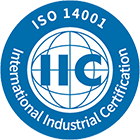ISO 14001

(1) Background
ISO 14001, one of ISO 14000 series standard and built by ISO, is an International Standard for Environmental Management System to support a series of management activities to continuously improve the environmental performance through life cycle of organization’s activities, products, and services. Like ISO 9001, this is the certification system that the 3rd party certification body conducts the audit on the organization’s environmental management system and ensures whether it conforms to the requirements. This standard includes major requirements for operating an efficient environmental management system, including environmental aspects and impacts on all processes, products and services carried out within the company. This standard is designed to evaluate the environmental management system of suppliers and made to apply for the various industries such as manufacture, construction, and service. In the past, the first (1996) and the second (2004) revisions were used. Currently, the third revision (2015) published on 15 September 2015 is applicable.
(2) Benefits of ISO 14001 Certification
- Saving resources through clear authority and responsibility.
- Improving the cost management through recycling.
- Reducing environmental accidents.
- Enhancing company image and reliability in local community.
- Complying with legal environmental requirements.
(3) Protection of the environment and prevention of pollution
a) Practical measures to protect the environment can include:
- improved efficiency in use of natural resources, such as water and fossil fuels, for example, through reducing the use, or engaging in re-use or recycling of, natural resources relative to production.
- protection of biodiversity, habitats and ecosystems through direct on-site conservation, or indirectly through procurement decisions, such as buying materials from verified sustainable sources.
- climate change mitigation through avoiding or reducing emissions of greenhouse gases, or adopting carbon neutrality policies in order to reduce its net contribution to climate change.
- improvement in air and water quality through avoidance, substitution or reduction.
b) Prevention of pollution
- substitution, process, product or technology changes, and conservation of energy and material resources);
- reuse or recycling of materials within the process or facility;
- offsite reuse or recycling of materials;
- recovery and treatment (recovery from waste streams on or offsite, treatment of emissions, and releases of
- wastes on or offsite to reduce their environmental impacts);
- control mechanisms, such as incineration or controlled disposal, where permissible.
(4) Interested Parties, Needs and Expectations
| Interested Party | Needs and Expectations |
|---|---|
| Investors | Expect the organization to manage its risks and opportunities that can affect an investment |
| Non-governmental organizations (NGOs) | Need the organization’s cooperation to achieve the NGO’s environmental goals |
| Neighbors, the community | Expect socially acceptable performance, honesty and integrity |
| Employees | Expect to work in a safe and healthy environment |
| Industry membership organization | Need collaboration on environmental issues |
| Regulatory or statutory agencies | Expect demonstration of legal compliance |
(5) Performance indicators
Progress towards an environmental objective can generally be measured using environmental performance indicators, such as:
- quantity of raw material or energy used;
- quantity of emissions, such as CO2;
- waste produced per quantity of finished product;
- efficiency of material and energy used;
- number of environmental incidents (e.g. excursions above limits);
- number of environmental accidents (e.g. unplanned releases);
- percentage waste recycled;
- percentage recycled material used in packaging;
- number of service vehicle kilometres per unit of production;
- quantities of specific pollutants emitted, e.g. NOx, SOx, CO, VOCs, Pb and CFCs;
- investment in environmental protection;
- number of prosecutions;
- land area set aside for wildlife habitat;
- number of persons trained in environmental aspect identification;
- percentage of budget spent on low emission technology.


